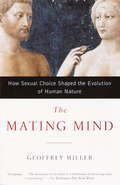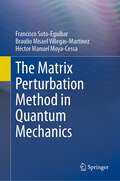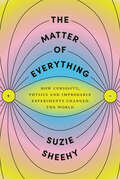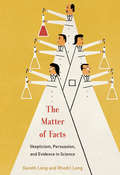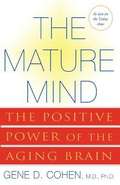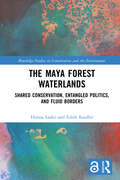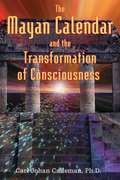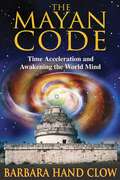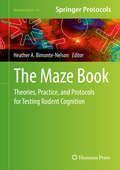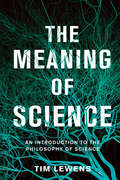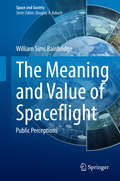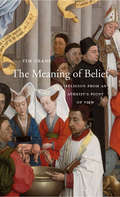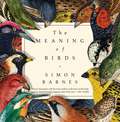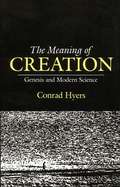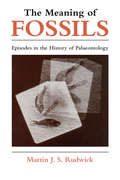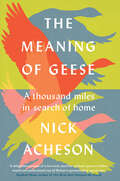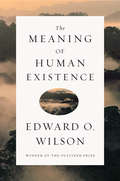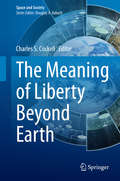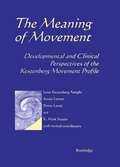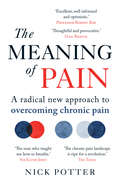- Table View
- List View
The Mating Mind
by Geoffrey MillerAt once a pioneering study of evolution and an accessible and lively reading experience, The Mating Mind marks the arrival of a prescient and provocative new science writer. Psychologist Geoffrey Miller offers the most convincing-and radical-explanation for how and why the human mind evolved. Consciousness, morality, creativity, language, and art: these are the traits that make us human. Scientists have traditionally explained these qualities as merely a side effect of surplus brain size, but Miller argues that they were sexual attractors, not side effects. He bases his argument on Darwin's theory of sexual selection, which until now has played second fiddle to Darwin's theory of natural selection, and draws on ideas and research from a wide range of fields, including psychology, economics, history, and pop culture. Witty, powerfully argued, and continually thought-provoking, The Mating Mind is a landmark in our understanding of our own species.From the Trade Paperback edition.
The Matrix Perturbation Method in Quantum Mechanics
by Francisco Soto-Eguibar Braulio Misael Villegas-Martínez Héctor Manuel Moya-CessaThis book provides an alternative approach to time-independent perturbation theory in non-relativistic quantum mechanics. It allows easy application to any initial condition because it is based on an approximation to the evolution operator and may also be used on unitary evolution operators for the unperturbed Hamiltonian in the case where the eigenvalues cannot be found. This flexibility sets it apart from conventional perturbation theory. The matrix perturbation method also gives new theoretical insights; for example, it provides corrections to the energy and wave function in one operation. Another notable highlight is the facility to readily derive a general expression for the normalization constant at m-th order, a significant difference between the approach within and those already in the literature. Another unique aspect of the matrix perturbation method is that it can be extended directly to the Lindblad master equation. The first and second-order corrections are obtained for this equation and the method is generalized for higher orders. An alternative form of the Dyson series, in matrix form instead of integral form, is also obtained. Throughout the book, several benchmark examples and practical applications underscore the potential, accuracy and good performance of this novel approach. Moreover, the method's applicability extends to some specific time-dependent Hamiltonians. This book represents a valuable addition to the literature on perturbation theory in quantum mechanics and is accessible to students and researchers alike.
The Matter of Everything: How Curiosity, Physics, and Improbable Experiments Changed the World
by Suzie SheehyA surprising, fascinating journey through the experiments that not only unlocked the nature of matter and shaped our understanding of the cosmos but also forever changed the way we live within it"A book about the fundamental problems of physics written from a viewpoint I hadn&’t come across before: that of the experimenter. A splendid idea, vividly carried out.&” –Philip Pullman, best-selling author of His Dark MaterialsPhysics has always sought to deepen our understanding of the nature of matter and the world around us. But how do you conduct experiments with the fundamental building blocks of existence? How do you manipulate a particle a trillion times smaller than a grain of sand? How do you cause a proton to sail around a twenty-seven-kilometer-long loop 11,000 times per second? And, crucially, why is all this important?In The Matter of Everything, accelerator physicist Suzie Sheehy introduces us to the people who, through a combination of genius, persistence and luck, staged the experiments that changed the course of history. From the serendipitous discovery of X-rays in a German laboratory to the scientists trying to prove Einstein wrong (and inadvertently proving him right) to the race to split open the atom, these brilliant experiments led to some of the most significant breakthroughs in science and fundamentally changed our lives. They have helped us detect the flow of lava deep inside volcanoes, develop life-saving medical techniques like diagnostic imaging and radiation therapy, and create radio, TV, microwaves, smartphones—even the World Wide Web itself—among countless other advancements.Along the way, Sheehy pulls back the curtain to reveal how physics is really done—not only by theorists with equation-filled blackboards but also by experimentalists with hand-blown glass, hot air balloons and cathedral-sized electronics. Celebrating human ingenuity, creativity and above all curiosity, The Matter of Everything is an inspiring story of discovery and a powerful reminder that progress is a function of our desire to know.
The Matter of Facts: Skepticism, Persuasion, and Evidence in Science (The\mit Press Ser.)
by Gareth Leng Rhodri Ivor LengHow biases, the desire for a good narrative, reliance on citation metrics, and other problems undermine confidence in modern science.Modern science is built on experimental evidence, yet scientists are often very selective in deciding what evidence to use and tend to disagree about how to interpret it. In The Matter of Facts, Gareth and Rhodri Leng explore how scientists produce and use evidence. They do so to contextualize an array of problems confronting modern science that have raised concerns about its reliability: the widespread use of inappropriate statistical tests, a shortage of replication studies, and a bias in both publishing and citing “positive” results. Before these problems can be addressed meaningfully, the authors argue, we must understand what makes science work and what leads it astray. The myth of science is that scientists constantly challenge their own thinking. But in reality, all scientists are in the business of persuading other scientists of the importance of their own ideas, and they do so by combining reason with rhetoric. Often, they look for evidence that will support their ideas, not for evidence that might contradict them; often, they present evidence in a way that makes it appear to be supportive; and often, they ignore inconvenient evidence.In a series of essays focusing on controversies, disputes, and discoveries, the authors vividly portray science as a human activity, driven by passion as well as by reason. By analyzing the fluidity of scientific concepts and the dynamic and unpredictable development of scientific fields, the authors paint a picture of modern science and the pressures it faces.
The Matter of the Heart: A History of the Heart in Eleven Operations
by Thomas Morris“More than a litany of medical advances—it’s the story of the gritty, bloody and deadly experiences that underlie scientific progress.” —Washington PostAn eye-opening and heroic story of pioneering heart surgeons, structured around eleven operations.For thousands of years the human heart remained the deepest of mysteries; both home to the soul and an organ too complex to touch, let alone operate on.Then, in the late nineteenth century, medics began going where no one had dared go before. The following decades saw the mysteries of the heart exposed, thanks to pioneering surgeons, brave patients and even sacrificial dogs.In eleven landmark operations, Thomas Morris tells us stories of triumph, reckless bravery, swaggering arrogance, jealousy and rivalry, and incredible ingenuity: the trail-blazing ‘blue baby’ procedure that transformed wheezing infants into pink, healthy children; the first human heart transplant, which made headline news around the globe. And yet the heart still feels sacred: just before the operation to fit one of the first artificial hearts, the patient’s wife asked the surgeon if he would still be able to love her.The Matter of the Heart gives us a view over the surgeon’s shoulder, showing us the heart’s inner workings and failings. It describes both a human story and a history of risk-taking that has ultimately saved millions of lives.“A thoroughly engaging history.” —The Wall Street Journal“Morris’s expert guided tour of cardiac surgery and its quirky, brilliant innovators covers a dazzling and dizzying array of procedures and hints at tantalizing prospects for future surprises.” —Publishers Weekly, starred review“A well-developed narrative with no end of heroes.’“ —Kirkus Reviews“Gripping.” —John Crace, The Guardian
The Mature Mind: The Positive Power of the Aging Brain
by Gene D. CohenPsychological aspects of the aging brain
The Maya Forest Waterlands: Shared Conservation, Entangled Politics, and Fluid Borders (Routledge Studies in Conservation and the Environment)
by Hanna Laako Edith KaufferThis book examines the entanglements and blurred edges of nature conservation and geopolitical relations in the borderlands of the trinational Maya Forest.Maya Forest is an umbrella term for transboundary conservation developed by scientists and conservationists in the 1990s to protect the threatened rainforest in the borderlands of Mexico, Belize, and Guatemala. Currently, the Maya Forest is a biodiversity hotspot composed of a network of protected areas and heritage sites. However, issues related to water, land, and forests have often been treated as separate political units, and not as part of the same history. Written by two authors with decades of hands-on experience in this region, this book sheds light on the complex dynamics by which conservation and natural resource management geopolitically shape borderlands such as the Maya Forest. The book introduces the novel concept of forest waterlands as borderlands and fluid edges, which are now subject to concern by conservationists. These are entangled spaces in which conservation, peoples, and politics interact, connect, and disconnect with the nexus of waters, forests, and lands. The book sheds light on the building and mapping of the Maya Forest ecoregion, with particular attention to water as an often neglected, but unifying element. It showcases how the Maya Forest is a distinct region characterized by transformations entangled with the Maya, trails of biological stations, the shared history of chicleros (chewing-gum hunters), fluid international rivers and transboundary basins, and various geopolitical discrepancies. It offers a contemporary glimpse into the Maya Forest’s intertwined bio- and geopolitics, which urge us to rethink borders and boundaries.This book will be of great interest to students and scholars of nature conservation, global environmental politics, geopolitics, borderlands, international relations, and natural resource management.
The Maya and Their Neighbors: Essays on Middle American Anthropology and Archaeology
by Clarence L. Hay Ralph L. Linton Samuel K. Lothrop Harry L. Shapiro George C. VaillantThe civilizations created by the Maya and their neighbors have for four centuries excited the imagination of the romantic, attracted the curiosity of the intellectually alert, and challenged the intelligence of the scholar.
The Mayan Calendar and the Transformation of Consciousness
by Carl Johan CallemanReveals the Mayan calendar to be a spiritual device that describes the evolution of human consciousness from ancient times into the future• Shows the connection between cosmic evolution and actual human history• Provides a new science of time that explains why time not only seems to be speeding up in the modern world but is actually getting faster• Explains how the end of the Mayan calendar is not the end of the world, but a path toward enlightenmentThe prophetic Mayan calendar is not keyed to the movement of planetary bodies. Instead, it functions as a metaphysical map of the evolution of consciousness and records how spiritual time flows--providing a new science of time.The calendar is associated with nine creation cycles, which represent nine levels of consciousness or Underworlds on the Mayan cosmic pyramid. Through empirical research Calleman shows how this pyramidal structure of the development of consciousness can explain things as disparate as the common origin of world religions and the modern complaint that time seems to be moving faster. Time, in fact, is speeding up as we transition from the materialist Planetary Underworld of time that governs us today to a new and higher frequency of consciousness--the Galactic Underworld--in preparation for the final Universal level of conscious enlightenment. Calleman reveals how the Mayan calendar is a spiritual device that enables a greater understanding of the nature of conscious evolution throughout human history and the concrete steps we can take to align ourselves with this growth toward enlightenment.
The Mayan Code: Time Acceleration and Awakening the World Mind
by Carl Johan Calleman Barbara Hand ClowBestselling author Barbara Hand Clow shows how the Mayan Calendar is a bridge to galactic wisdom that fosters personal growth and human evolution • Unearths the meaning behind the calendar, its message for modern civilization, and what will happen when the calendar ends • Reveals how time acceleration is a manifestation of the acceleration of consciousness • By the author of The Pleiadian Agenda The Mayan Code is a deep exploration of how, as we approach the end of the Mayan Calendar, time and consciousness are accelerating, giving us a new understanding of the universe. Using Carl Johan Calleman’s research, as well as the ideas of other Mayan Calendar scholars, Barbara Hand Clow examines 16.4 billion years of evolution to decode the creative patterns of Earth--the World Mind. These great patterns culminate in 2011, and then during 2012 major astrological influences will inspire us to attain oneness and enlightenment. The Mayan Code shows how the time cycles of the Calendar match important periods in the evolutionary data banks of Earth and the Milky Way Galaxy. These stages of evolution are converging during the final stage of the Calendar, the period between 1999 and 2011. War and territoriality, resource management and separation from nature, are all part of daily events we must process during these few short years: evidence of the tightening spiral of time that we experience as time speeding up. Barbara Hand Clow counsels that our own personal healing is the most important factor as we prepare to make this critical leap in human evolution--now referred to as the awakening of the World Mind.
The Maze Book
by Heather A. Bimonte-NelsonThis vibrant collection delivers a laboratory roadmap of testing cognition in the rodent. While rodents and mazes are the main center and focus of this book, many aspects in the field of learning and memory are discussed and detailed, spanning from the molecular to the human, with every chapter delivering a comprehensive review of historical milestones in order to provide context for past discoveries, new findings, and future studies. Didactic foundations, operational definitions, and theory, as well as practical experimental and apparatus set-up, data analysis, and interpretation instructions are included in the first part of the book, while part two contains step-by-step protocols, troubleshooting, and tips from experts in the field. Authoritative and inspirational, The Maze Book: Theories, Practice, and Protocols for Testing Rodent Cognition serves as a detailed and practical manual for scientists wishing to implement these tools in their laboratories and for scholars interested in this powerful field.
The Meaning Of Science: An Introduction To The Philosophy Of Science
by Tim LewensScience has produced explanations for everything from the mechanisms of insect navigation to the formation of black holes and the workings of black markets. But how much can we trust science, and can we actually know the world through it? How does science work and how does it fail? And how can the work of scientists help--or hurt--everyday people? These are not questions that science can answer on its own. This is where philosophy of science comes in. Studying science without philosophy is, to quote Einstein, to be "like somebody who has seen thousands of trees but has never seen a forest. " Cambridge philosopher Tim Lewens shows us the forest. He walks us through the theories of seminal philosophers of science Karl Popper and Thomas Kuhn and considers what science is, how far it can and should reach, and how we can determine the nature of its truths and myths. These philosophical issues have consequences that stretch far beyond the laboratory. For instance: What role should scientists have in policy discussions on environmental issues such as fracking? What are the biases at play in the search for a biological function of the female orgasm? If brain scans can be used to demonstrate that a decision was made several seconds before a person actually makes a conscious choice, what does that tell us about the possibility of free will? By examining science through this philosophical lens, Lewens reveals what physics can teach us about reality, what biology teaches us about human nature, and what cognitive science teaches us about human freedom. A masterful analysis of the biggest scientific and ethical issues of our age, The Meaning of Science forces us to confront the practical, personal, and political purposes of science--and why it matters to all of us.
The Meaning and Value of Spaceflight
by William Sims BainbridgeThis book presents the most serious and comprehensive study, by far, of American public perceptions about the meaning of space exploration, analyzing vast troves of questionnaire data collected by many researchers and polling firms over a span of six decades and anchored in influential social science theories. It doesn't simply report the percentages who held various opinions, but employs sophisticated statistical techniques to answer profound questions and achieve fresh discoveries. Both the Bush and the Obama administrations have cut back severely on fundamental research in space science and engineering. Understanding better what space exploration means for citizens can contribute to charting a feasible but progressive course. Since the end of the Space Race between the US and the USSR, social scientists have almost completely ignored space exploration as a topic for serious analysis and this book seeks to revive that kind of contribution. The author communicates the insights in a lucid style, not only intelligible but interesting to readers from a variety of backgrounds.
The Meaning of Belief: Religion from an Atheist’s Point of View
by Tim CraneCurrent debate about religion seems to be going nowhere. Atheists persist with their arguments, many plausible and some unanswerable, but they make no impact on believers. Defenders of religion find atheists equally unwilling to cede ground. Noting that religion is not what atheists think it is, Tim Crane offers a way out of this stalemate.
The Meaning of Birds
by Simon BarnesA gorgeously illustrated and enchanting examination of the lives of birds, illuminating their wondrous world and our connection with them. One of our most eloquent nature writers offers a passionate and informative celebration of birds and their ability to help us understand the world we live in. As well as exploring how birds achieve the miracle of flight; why birds sing; what they tell us about the seasons of the year and what their presence tells us about the places they inhabit, The Meaning of Birds muses on the uses of feathers, the drama of raptors, the slaughter of pheasants, the infidelities of geese, and the strangeness of feeling sentimental about blue tits while enjoying a chicken sandwich. From the mocking-birds of the Galapagos who guided Charles Darwin toward his evolutionary theory, to the changing patterns of migration that alert us to the reality of contemporary climate change, Simon Barnes explores both the intrinsic wonder of what it is to be a bird—and the myriad ways in which birds can help us understand the meaning of life.
The Meaning of Creation (Genesis and Modern Science)
by Conrad HyersAnyone who would propose to offer an interpretation of what the Genesis accounts of creation "really mean" must do so with considerable caution. There have been many different interpretations sent back to Europe, so to speak, not only of the meaning of the whole but of every verse, even every word. Perhaps this great variety of interpretation is an indication of the richness and subtlety of the creation stories themselves, which can suggest such a diversity of meanings. Perhaps, too, this variety is a reflection of the interpreters themselves, coming to these ancient texts from such a diversity of ages, cultures, philosophies, academic fields, methodologies, and religious persuasions. As in the case of the Dutch anthropologist, it is very easy to shape materials which come to us from a distant culture, language, and time to fit our own modes of thought and the issues that concern us.
The Meaning of Fossils: Episodes in the History of Palaeontology
by Martin J.S. Rudwick"It is not often that a work can literally rewrite a person's view of a subject. And this is exactly what Rudwick's book should do for many paleontologists' view of the history of their own field."—Stephen J. Gould, Paleobotany and Palynology "Rudwick has not merely written the first book-length history of palaeontology in the English language; he has written a very intelligent one. . . . His accounts of sources are rounded and organic: he treats the structure of arguments as Cuvier handled fossil bones."—Roy S. Porter, History of Science
The Meaning of Fossils: Episodes in the History of Palaeontology, Second Edition
by Martin J. S. Rudwick"It is not often that a work can literally rewrite a person's view of a subject. And this is exactly what Rudwick's book should do for many paleontologists' view of the history of their own field. "—Stephen J. Gould, Paleobotany and Palynology "Rudwick has not merely written the first book-length history of palaeontology in the English language; he has written a very intelligent one. . . . His accounts of sources are rounded and organic: he treats the structure of arguments as Cuvier handled fossil bones. "—Roy S. Porter, History of Science
The Meaning of Geese: A Thousand Miles in Search of Home
by Nick Acheson‘A magisterial diary for bird lovers.’ Observer ⭐⭐⭐⭐ The Telegraph As seen on BBC Winterwatch 2023 ‘Honest, human and heart-grabbing. I loved this book so much.’ Sophie Pavelle, author of Forget Me Not ‘Delightful’ Stephen Moss, author of Ten Birds that Changed the World ‘Fascinating and thought-provoking’ Jake Fiennes, author of Land Healer ‘Awe-filled and absorbing’ Nicola Chester, author of On Gallows Down The Meaning of Geese is a book of thrilling encounters with wildlife, of tired legs, punctured tyres and inhospitable weather. Above all, it is the story of Nick Acheson’s love for the land in which he was born and raised, and for the wild geese that fill it with sound and spectacle every winter. Renowned naturalist and conservationist Nick Acheson spent countless hours observing and researching wild geese, transported through all weathers by his mother’s 40-year-old trusty red bicycle. He meticulously details the geese’s arrival, observing what they mean to his beloved Norfolk and the role they play in local people’s lives – and what role the birds could play in our changing world. During a time when many people faced the prospect of little work or human contact, Nick followed the pinkfeet and brent geese that filled the Norfolk skies and landscape as they flew in from Iceland and Siberia. In their flocks, Nick encountered rarer geese, including Russian white-fronts, barnacle geese and an extremely unusual grey-bellied brant, a bird he had dreamt of seeing since thumbing his mother’s copy of Peter Scott’s field guide as a child. To honour the geese’s great athletic migrations, Nick kept a diary of his sightings as well as the stories he discovered through the community of people, past and present, who loved them, too. Over seven months Nick cycles over 1,200 miles – the exact length of the pinkfeet’s migration to Iceland.
The Meaning of Geese: A Thousand Miles in Search of Home
by Nick Acheson‘A magisterial diary for bird lovers.’ ObserverWINNER – BOOK OF THE YEAR - East Anglian Book Awards 2023⭐⭐⭐⭐ The TelegraphAs seen on BBC Winterwatch 2023‘Honest, human and heart-grabbing. I loved this book so much.’ Sophie Pavelle, author of Forget Me Not‘Delightful’ Stephen Moss, author of Ten Birds that Changed the World‘Fascinating and thought-provoking’ Jake Fiennes, author of Land Healer‘Awe-filled and absorbing’ Nicola Chester, author of On Gallows DownThe Meaning of Geese is a book of thrilling encounters with wildlife, of tired legs, punctured tyres and inhospitable weather. Above all, it is the story of Nick Acheson’s love for the land in which he was born and raised, and for the wild geese that fill it with sound and spectacle every winter.Renowned naturalist and conservationist Nick Acheson spent countless hours observing and researching wild geese, transported through all weathers by his mother’s 40-year-old trusty red bicycle. He meticulously details the geese’s arrival, observing what they mean to his beloved Norfolk and the role they play in local people’s lives – and what role the birds could play in our changing world. During a time when many people faced the prospect of little work or human contact, Nick followed the pinkfeet and brent geese that filled the Norfolk skies and landscape as they flew in from Iceland and Siberia. In their flocks, Nick encountered rarer geese, including Russian white-fronts, barnacle geese and an extremely unusual grey-bellied brant, a bird he had dreamt of seeing since thumbing his mother’s copy of Peter Scott’s field guide as a child.To honour the geese’s great athletic migrations, Nick kept a diary of his sightings as well as the stories he discovered through the community of people, past and present, who loved them, too. Over seven months Nick cycles over 1,200 miles – the exact length of the pinkfeet’s migration to Iceland.
The Meaning of Human Existence
by Edward O. WilsonNational Book Award Finalist. How did humanity originate and why does a species like ours exist on this planet? Do we have a special place, even a destiny in the universe? Where are we going, and perhaps, the most difficult question of all, "Why?" In The Meaning of Human Existence, his most philosophical work to date, Pulitzer Prize-winning biologist Edward O. Wilson grapples with these and other existential questions, examining what makes human beings supremely different from all other species. Searching for meaning in what Nietzsche once called "the rainbow colors" around the outer edges of knowledge and imagination, Wilson takes his readers on a journey, in the process bridging science and philosophy to create a twenty-first-century treatise on human existence--from our earliest inception to a provocative look at what the future of mankind portends. Continuing his groundbreaking examination of our "Anthropocene Epoch," which he began with The Social Conquest of Earth, described by the New York Times as "a sweeping account of the human rise to domination of the biosphere," here Wilson posits that we, as a species, now know enough about the universe and ourselves that we can begin to approach questions about our place in the cosmos and the meaning of intelligent life in a systematic, indeed, in a testable way. Once criticized for a purely mechanistic view of human life and an overreliance on genetic predetermination, Wilson presents in The Meaning of Human Existence his most expansive and advanced theories on the sovereignty of human life, recognizing that, even though the human and the spider evolved similarly, the poet's sonnet is wholly different from the spider's web. Whether attempting to explicate "The Riddle of the Human Species," "Free Will," or "Religion"; warning of "The Collapse of Biodiversity"; or even creating a plausible "Portrait of E.T.," Wilson does indeed believe that humanity holds a special position in the known universe. The human epoch that began in biological evolution and passed into pre-, then recorded, history is now more than ever before in our hands. Yet alarmed that we are about to abandon natural selection by redesigning biology and human nature as we wish them, Wilson soberly concludes that advances in science and technology bring us our greatest moral dilemma since God stayed the hand of Abraham.
The Meaning of Liberty Beyond Earth
by Charles S. CockellThe purpose of this book is to initiate a new discussion on liberty focusing on the infinite realms of space. The discussion of the nature of liberty and what it means for a human to be free has occupied the minds of thinkers since the Enlightenment. However, without exception, every one of these discussions has focused on the character of liberty on the Earth. The emergence of human space exploration programs in the last 40-50 years raise a fundamental and new question: what will be the future of liberty in space? This book takes the discussion of liberty into the extraterrestrial environment. In this book, new questions will be addressed such as: Can a person be free when the oxygen the individual breathes is the result of a manufacturing process controlled by someone else? Will the interdependence required to survive in the extremities of the extraterrestrial environment destroy individualism? What are the obligations of the individual to the extraterrestrial state? How can we talk of extraterrestrial liberty when everyone is dependent on survival systems?
The Meaning of Movement: Developmental and Clinical Perspectives of the Kestenberg Movement Profile
by Janet Kestenberg Amighi Susan Loman Penny Lewis K. Mark SossinThe primary objective of this book is to present the Kestenberg Movement Profile (KMP)--a multi-tiered system for the notation of observed movement patterns, classification of these patterns, and analysis of an individual's movement repertoire.
The Meaning of Pain: A radical new approach to overcoming chronic pain
by Nick PotterWe all fear pain and we will do almost anything to avoid it. In The Meaning of Pain, renowned osteopath Nick Potter presents a radical new approach to treating chronic pain. He draws on insights from biology, evolution and social behaviour to help us understand why pain is essential to our survival, and how we can manage our experience of it. In this sage and enlightening book, drawing on 25 years of clinical experience and success stories from his consulting room, Potter presents a timely, compelling roadmap for wellbeing, showing us how to break the vicious cycle of stress, pain and anxiety before the damage is done.
The Meaning of Pain: A radical new approach to overcoming chronic pain
by Nick PotterWe all fear pain and we will do almost anything to avoid it. In The Meaning of Pain, renowned osteopath Nick Potter presents a radical new approach to treating chronic pain. He draws on insights from biology, evolution and social behaviour to help us understand why pain is essential to our survival, and how we can manage our experience of it. In this sage and enlightening book, drawing on 25 years of clinical experience and success stories from his consulting room, Potter presents a timely, compelling roadmap for wellbeing, showing us how to break the vicious cycle of stress, pain and anxiety before the damage is done.
